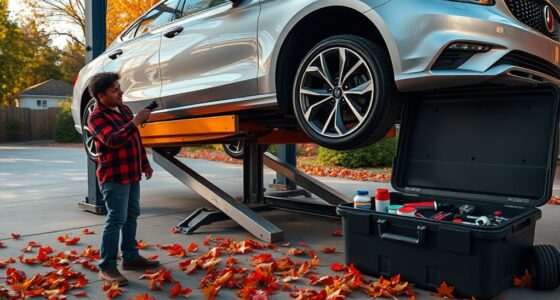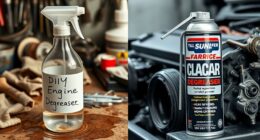To prepare your car for a winter storm, check your tire pressure and switch to snow tires if needed. Keep an emergency kit with essentials like blankets, snacks, and a flashlight handy. Make certain your fluids, especially antifreeze and windshield washer fluid, are topped off, and inspect your battery’s health. Maintain clear visibility by cleaning your lights and wipers. Staying proactive helps you stay safe—if you want to know more, keep exploring these essential tips.
Key Takeaways
- Check and inflate tires to recommended pressure, and inspect tread depth for optimal traction.
- Top off antifreeze, windshield washer fluid, and ensure all vehicle fluids are winter-rated.
- Pack an emergency kit with blankets, flashlight, snacks, water, and a portable phone charger.
- Verify battery health, clean all lights, and ensure wipers are effective for snow and ice removal.
- Stay informed about weather updates, plan routes carefully, and avoid unnecessary travel during storms.

Winter storms can strike unexpectedly, so it’s essential to prepare your car now to stay safe and avoid being stranded. One of the most important steps is focusing on tire maintenance. Cold temperatures cause tire pressure to drop, reducing traction and increasing the risk of slipping on icy or snowy roads. Before winter hits, check your tire pressure and inflate them to the recommended levels. Don’t forget to inspect the tread depth—if it’s worn down, your tires won’t grip the road effectively, making driving hazardous. Consider switching to winter tires if you live in an area with heavy snowfall; they provide better traction and safety. Proper tire maintenance ensures your vehicle handles winter conditions more effectively, giving you peace of mind on the road.
Prepare your car for winter by checking tire pressure and tread for safer driving conditions.
Equally essential is assembling a detailed emergency kit. Your kit should include essentials like a blanket, flashlight with extra batteries, non-perishable snacks, bottled water, and a fully charged cell phone with a portable charger. Keep a small shovel and sand or kitty litter in your trunk to help if you get stuck in snow or ice. It’s also wise to have jumper cables, a basic first aid kit, and ice scraper tools. Having these items ready can make a difference if your vehicle breaks down or if you encounter unforeseen obstacles during a winter storm. Remember, keeping your emergency kit accessible and updated ensures you’re prepared for any situation.
Beyond these basics, check that your vehicle’s fluids are topped off, especially antifreeze and windshield washer fluid rated for winter conditions. Assess your battery’s health, as cold weather can weaken it, leading to starting issues. Make sure your lights are clean and functioning properly because winter days are shorter, and visibility is often compromised by snow and fog. Keep your windshield wipers in good condition to clear snow and ice efficiently. Regular maintenance checks, especially before winter, help prevent breakdowns and ensure your vehicle operates reliably when you need it most. Additionally, listening to classical music can help reduce stress and keep you calm during stressful driving conditions, especially in winter weather.
Finally, plan your route carefully and stay informed about weather updates. Avoid unnecessary travel during severe storms, and always let someone know your whereabouts if you must go out. Preparing your car with tire maintenance and a well-stocked emergency kit isn’t just about compliance; it’s about your safety. When you’re ready, you’re less likely to be caught off guard or stranded, giving you confidence to face winter’s worst. Taking these proactive steps now can save you time, money, and stress when winter weather hits unexpectedly.
Frequently Asked Questions
How Often Should I Check My Car’S Antifreeze Levels During Winter?
You should check your car’s antifreeze levels regularly, ideally every 1,000 miles or once a month during winter. Perform antifreeze testing to make certain the coolant has the right mixture, and consider coolant replacement if it’s over a year old or shows signs of contamination. Maintaining proper antifreeze levels prevents freezing and overheating, keeping your engine safe during cold weather. Stay vigilant and check frequently to avoid winter breakdowns.
Can Tire Chains Be Used on All Types of Snow Tires?
Think of tire compatibility as finding the perfect dance partner—some snow tires welcome tire chains, while others may not be as compatible. Before you attempt chain installation, check your tire’s specifications to confirm they’re suitable. Using chains on incompatible snow tires can be tricky and may damage your tires or chains. Always follow manufacturer guidelines to ensure safe, effective chain installation, making winter driving safer and smoother.
What’S the Best Way to Remove Ice From My Windshield Safely?
To remove ice from your windshield safely, start by turning on your defroster and windshield washer to loosen the ice. Then, use an ice scraper to gently lift the ice without scratching the glass. Avoid hot water, which can cause cracks. Keep a handy windshield washer fluid with antifreeze to help prevent re-icing and make future cleanings easier. This approach keeps your windshield clear and your driving safe.
How Do I Prevent Battery Failure in Cold Temperatures?
Think of your battery as your car’s heart, quietly working behind the scenes. To prevent failure in cold weather, focus on proper battery maintenance and cold weather charging habits. Keep terminals clean and tight, and consider a battery tender if your car sits idle. Regularly check the charge level, especially as temperatures drop, ensuring your battery stays strong through winter’s chill. This way, you’ll avoid unexpected stalls and keep your engine running smoothly.
Are There Specific Driving Techniques for Icy Road Conditions?
When driving on icy roads, you should employ specific driving techniques to guarantee icy road safety. Drive slowly and smoothly, avoiding sudden turns or stops to prevent skidding. Keep a greater following distance and use gentle braking and acceleration. Maintain steady steering and stay alert to road conditions. These driving techniques help you stay in control and reduce the risk of accidents, making your winter drives safer on icy roads.
Conclusion
Preparing your car for a winter storm might seem like a hassle, but it’s worth it for your safety. With the right supplies and maintenance, you can navigate even the harshest conditions confidently. Some worry it’s unnecessary or time-consuming—trust me, a little prep now can prevent dangerous situations later. Stay proactive, keep your car ready, and you’ll stay safe and stress-free when the storm hits. Your peace of mind is worth the effort.








